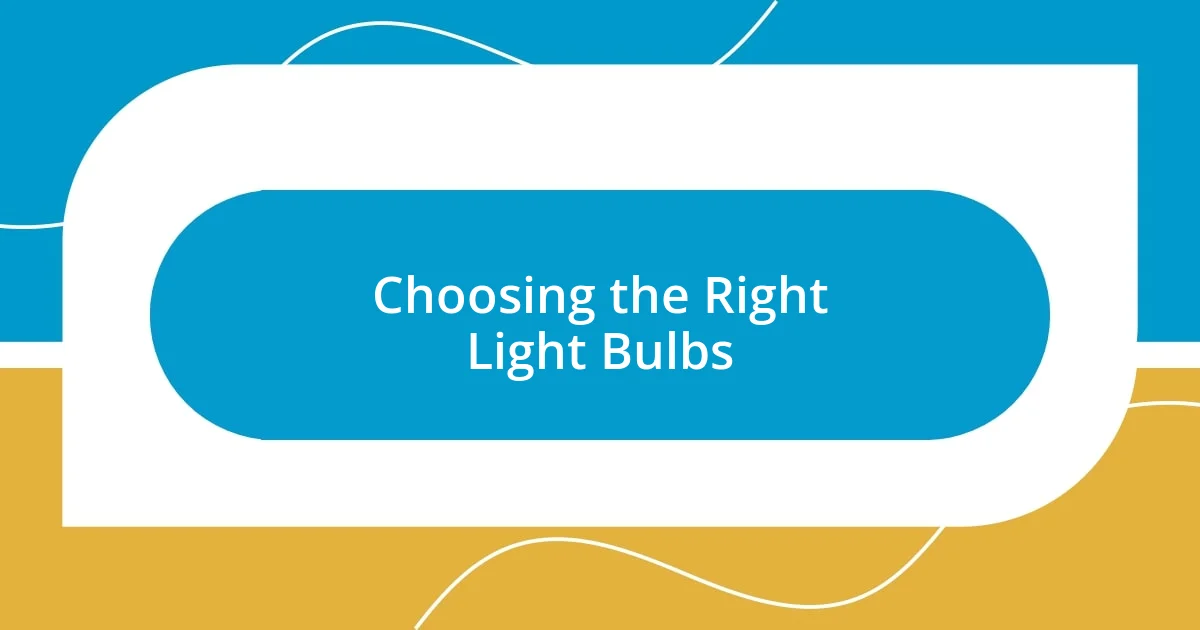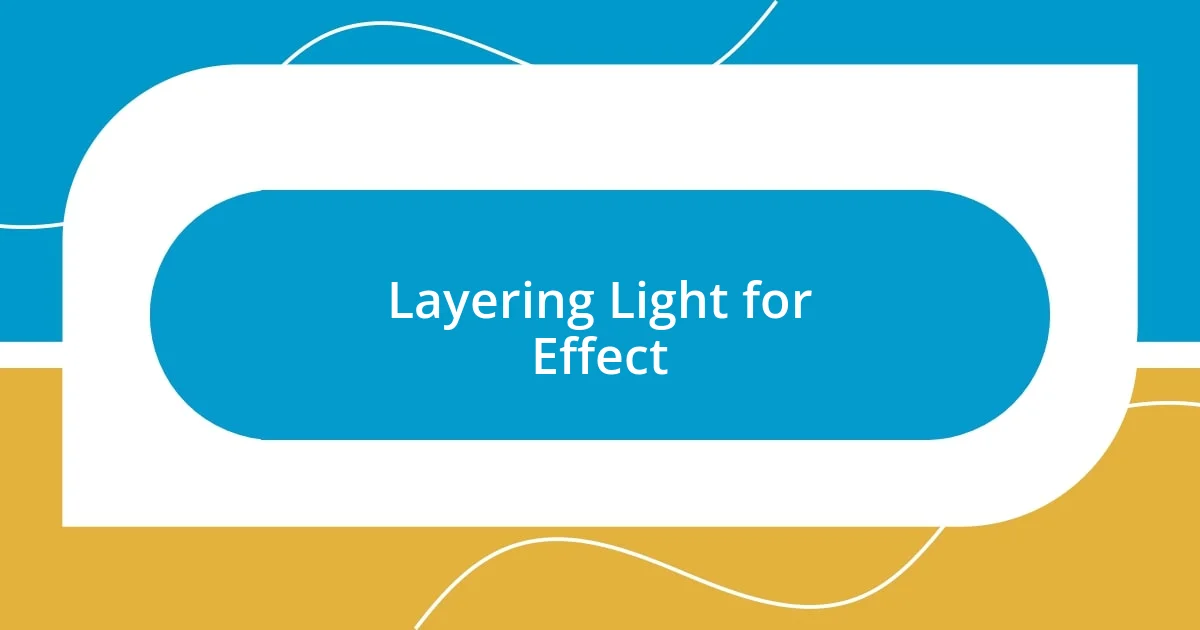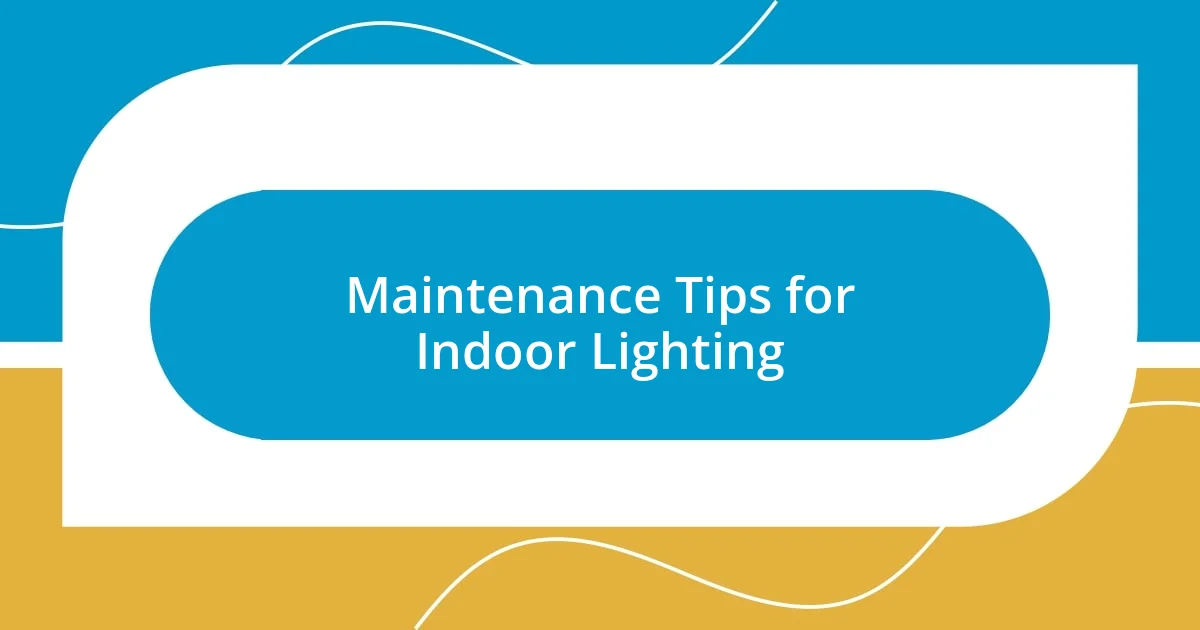Key takeaways:
- Different types of light sources and color temperatures significantly influence the mood and functionality of indoor spaces, with ambient, task, and accent lighting playing essential roles.
- Choosing the right light bulbs based on factors like color temperature, type, dimmability, and lifespan can enhance comfort, productivity, and atmosphere in each room.
- Utilizing natural light and implementing smart lighting solutions, along with regular maintenance, can significantly improve the overall ambiance and emotional appeal of indoor environments.

Understanding Indoor Lighting Basics
When I first started exploring indoor lighting, I was surprised to learn how different types of light sources can affect a room’s mood. For instance, I’ve found that soft, warm lights create a cozy vibe, perfect for relaxation, while bright, cool lights enhance focus, which is essential in workspaces. Isn’t it fascinating how just changing the color temperature can transform the entire atmosphere of our homes?
I remember a time when I was trying to find the right lighting for my living room. I experimented with various dimmable LED bulbs, and what struck me was how much I appreciated having control over brightness levels. The experience taught me that flexibility in lighting design not only serves practical purposes but also helps to set the emotional tone of a space.
Understanding the basics of indoor lighting means recognizing the balance between ambient, task, and accent lighting. Each layer serves a distinct purpose; think of ambient lighting as the foundation that illuminates the entire room, while task lighting focuses on specific activities, like reading or cooking. Have you ever noticed how a well-lit kitchen feels more inviting? It’s this interplay of light that enriches our everyday experiences, making our homes feel truly alive.

Choosing the Right Light Bulbs
Choosing the right light bulbs can feel overwhelming, but I’ve found that understanding a few key factors really simplifies the process. When I was revamping my home office, I opted for full-spectrum LED bulbs. Not only did they mimic natural daylight, but they also reduced eye strain during long hours of work. It was a game-changer for my productivity and mood!
To help you navigate your choices, consider the following tips:
- Color Temperature: Aim for bulbs between 2700K to 3000K for warm light, which is comforting, and 4000K to 5000K for cool light that promotes focus.
- Bulb Types: Decide between LED, CFL, and incandescent. I always prefer LED for their energy efficiency and longevity.
- Dimmability: Choose dimmable bulbs if you want to adjust brightness—this flexibility can significantly enhance a room’s atmosphere.
- Lumens vs. Watts: Look for lumens to measure brightness rather than watts, as modern bulbs use less energy for more light.
- Life Span: Consider the bulb’s lifespan; I typically go for bulbs rated at least 15,000 hours for convenience.
By thoughtfully selecting the right light bulbs, I’ve truly transformed my spaces, creating environments that are not only functional but also inviting and energizing. It’s like giving each room its own personality!

Layering Light for Effect
When I dive into the concept of layering light, I often reflect on how it can completely change the mood of a space. A few years ago, I had a light fixture installed in my dining area that allowed for multiple light sources. I remember hosting a dinner party and switching from bright overhead lighting to warm table lamps in the corner; it instantly transformed the atmosphere from sterile to intimate. This experience reinforced my belief that layering light is essential for creating dynamic environments.
One of the techniques I cherish is combining ambient, task, and accent lighting. Recently, I opted for a sleek floor lamp beside my favorite reading chair, complementing the overhead light. The layered approach not only brightened my reading nook but also allowed me to highlight artwork on the wall. Trust me, there’s something truly captivating about the interplay of shadows and highlights that arises from layered lighting.
To effectively layer light, I don’t just focus on utilizing different fixtures; I mindfully consider the placement and intensity of each light source. For instance, adding a soft accent light to my bookshelf significantly drew attention to its contents, creating a visual storytelling element in my living room. Have you ever rearranged your living space and noticed how lighting can change your perception of objects? This personal connection to light layering has empowered me to create spaces that resonate with both warmth and functionality.
| Layer | Purpose |
|---|---|
| Ambient | Provides overall illumination for the entire room |
| Task | Focuses light on specific activities (e.g., reading, cooking) |
| Accent | Adds visual interest by highlighting artwork or architectural features |

Utilizing Natural Light Sources
I’ve always appreciated how harnessing natural light can dramatically alter the ambiance of my indoor spaces. Last summer, my living room turned into a sun-drenched haven simply by rearranging the furniture to take advantage of a nearby window. The moment those warm rays cascaded onto my vibrant plants, I knew I had created a welcoming spot that breathed life and energy into the room.
Using mirrors is another technique I’ve found incredibly effective. I remember placing a large mirror across from a window in my hallway, and the way it reflected the daylight created an illusion of more space. It wasn’t just about amplifying the light; it made the entire corridor feel more inviting. Have you ever noticed how a burst of sunlight can motivate you to start your day? That’s the power of natural light—it has the ability to uplift your mood and spark inspiration.
Incorporating sheer curtains can also let in a soft glow while maintaining privacy. I still recall when I switched from heavy drapes to light, airy fabric in my bedroom. The shift was transformative! Now, gentle morning light filters through, gently nudging me awake like a warm embrace. Doesn’t it feel wonderful to step into a room filled with light? Embracing natural light has truly allowed my home to feel more expansive and alive, enhancing not just the aesthetic but my overall well-being.

Implementing Smart Lighting Solutions
Implementing smart lighting solutions can truly revolutionize how we experience our indoor environments. I vividly recall installing smart bulbs in my home office, which I can control from my phone. It was an absolute game-changer! The ease of adjusting the brightness depending on whether I was in work mode or winding down for the day made a noticeable difference in my productivity and relaxation.
One feature I love is the scheduling function; it’s like having a personal lighting assistant. For instance, I programmed the lights to gradually brighten in the morning, mirroring a natural sunrise. This gentle awakening feels so much more pleasant than a sudden jolt from an alarm. Have you ever tried setting your lights to align with your daily rhythm? It infuses a sense of harmony into my routine that I didn’t know I was missing.
I also enjoy experimenting with color-changing bulbs to enhance the mood for different activities. Last week, I decided to host a movie night and switched to a cozy, warm hue that transformed my living room into a theater-like experience. I felt the excitement in the air as everyone walked in and instantly knew it was the perfect ambiance for a night filled with laughter. It’s fascinating how color can alter our emotions; have you ever noticed how different lighting makes you feel? With smart lighting, the possibilities feel endless, allowing me to craft spaces that reflect my mood and style.

Creating Mood with Color Temperature
One of the most captivating aspects of indoor lighting is how color temperature can set the mood of a space. I remember when I switched to a cooler, bluish-white light in my kitchen, and it transformed my culinary adventures. Suddenly, cooking felt invigorating, almost like I was in a trendy café instead of my home. Isn’t it funny how a simple change in lighting can make such a significant difference in our daily lives?
Contrastingly, when I wanted to create a warm and cozy atmosphere in my den for a winter evening with friends, I leaned towards soft, warm light. I filled the space with a rich golden hue, inviting laughter and comfortable conversation. Don’t you love that feeling of being wrapped in warmth on a chilly night? In that moment, the room felt like a safe cocoon, fostering connection and relaxation.
In spaces meant for rest, like my bedroom, I’ve found that warmer tones can really help ease my mind after a long day. A bedtime ritual of gradually dimming the lights allows me to unwind, reflecting on my day in a peaceful environment. Have you ever noticed how certain colors just seem to wrap around you like a blanket? It’s truly remarkable how intentional choices in color temperature can craft emotional landscapes within our homes.

Maintenance Tips for Indoor Lighting
Maintaining indoor lighting isn’t just about keeping bulbs bright; it’s about preserving the atmosphere of your living space. I remember when I neglected my overhead fixtures, only to discover how dust buildup can dull the glow. A quick clean with a soft cloth instantly revived the light’s brilliance, making the entire room feel more inviting. Have you ever noticed how something as simple as a little dust can dim not just the light but the mood in a room?
Regularly checking the bulbs is another essential part of maintenance. I’ve had moments where I walked into a room, flicked the switch, and got hit with the disappointment of a burnt-out bulb. Now, I keep a small stash of spare bulbs in my utility drawer. That little preparation has turned inevitable frustration into a smooth experience. It’s amazing how being proactive about something as straightforward as light can elevate your daily routine.
Lastly, don’t overlook the importance of the right light fixtures. I once replaced a standard lamp in my reading nook with one that offered adjustable height and direction. Suddenly, my reading experience was transformed; no longer was I squinting to see the words. Choosing the right fixture not only enhances light quality but also contributes to the overall aesthetics of the room. Have you thought about how your fixtures affect both functionality and style? It’s those thoughtful choices that make our spaces genuinely feel like home.












